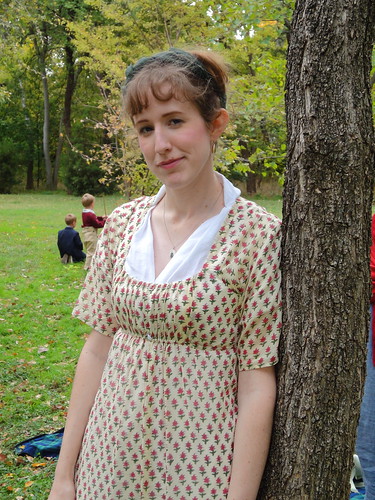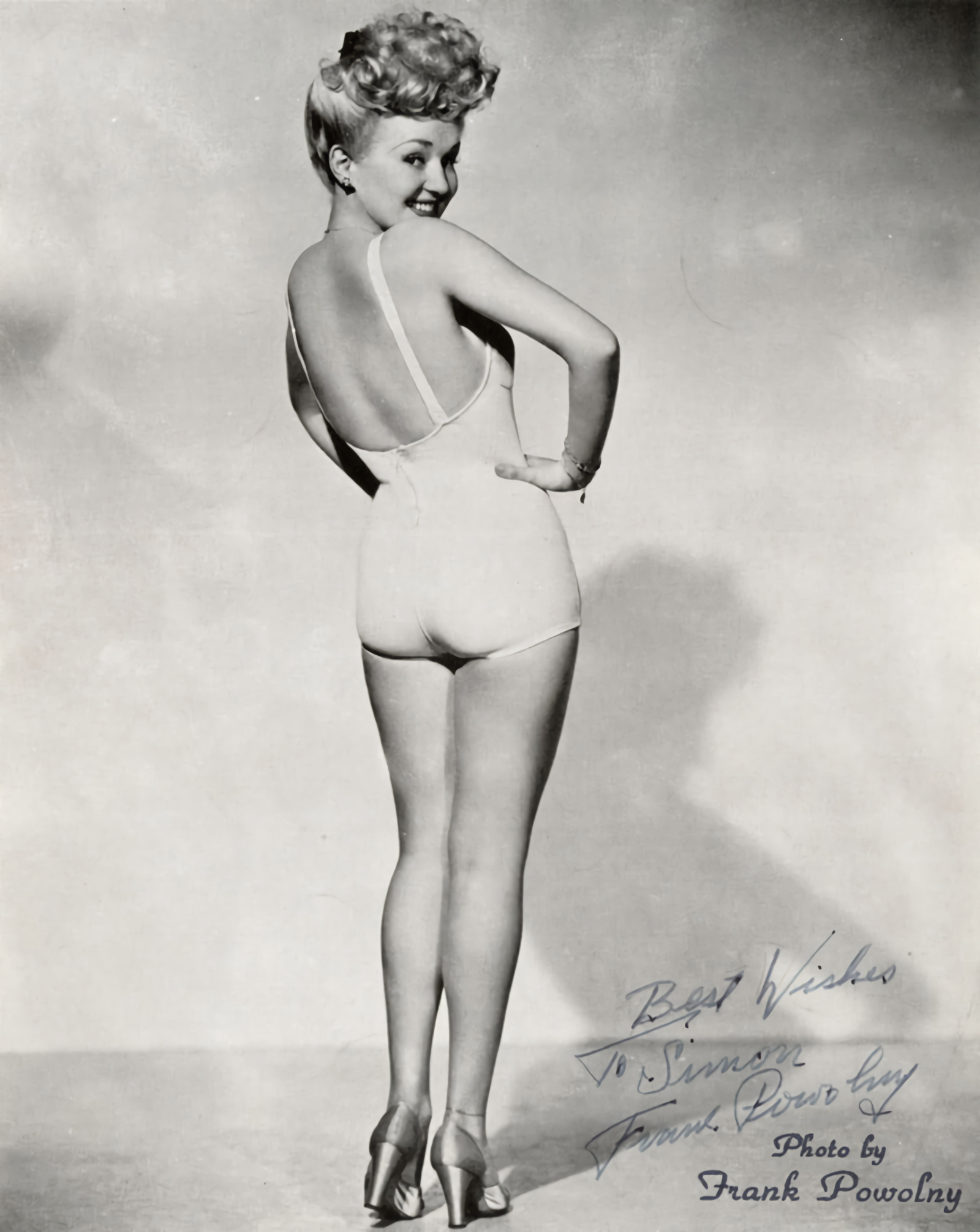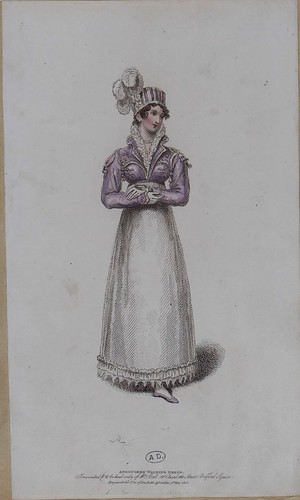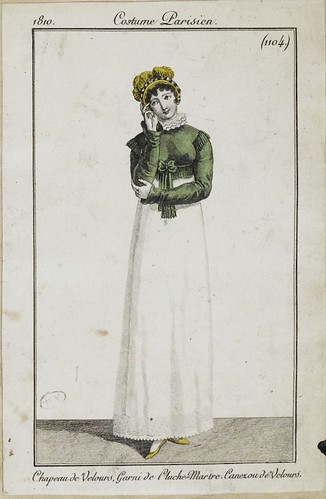 |
| Photo by Festive Attyre, who was certainly not to blame for the lack of a pose. |
I've thought about researching how to pose; Stephanie shared some terrific posing basics recently. But those are general techniques. What poses did they do back then? And which "then" are we talking about? Take Betty Grable's iconic pinup.
 |
| Source |
So mostly for my own education and entertainment, I'm going to make an informal survey of original pictures from different periods to figure out a handful of basic poses for each. Particularly I'm going to focus on full-length, standing-still views that don't rely on large props like furniture, or seated poses without tables or other things. Usually when I take costume pictures I'm without any props except for what I carry, such as in the halls at Costume College. My best opportunities tend to be a tree or two when I'm outside.
First up, I'm starting with the Regency period. The Picnic with the Pixies is Saturday, and I want to be prepared!
* The title line is from the song "Charade," from the 1963 movie of the same name. Music by Henry Mancini, lyrics by Johnny Mercer.
The Classical Ideal: Posing in the Regency Style
Free Standing
I prefer portraits, because they don't tend to suffer from bad drawing or out of proportion figures like fashion plates do. However, full-length free-standing portraits are rare. Anne has the benefit of a romantic seaside backdrop, and a shawl that is both rippling in the wind and velcro'd to her left elbow. But the right hand placement is graceful, and her hidden left hand could be holding a reticule or parasol. Her whole body, and her head, are angled slightly away from the viewer. One foot is foward.
From a fashion plate, but this is just a single example of a very simple and common pose. Face and body straight or barely angled to the viewer with one arm down by her side holding something (anything - just make sure it's something) and the other bent at an acute angle, with the hand just across the centerline of the body. White space is achieved between both arms and the waist. Feet are in fourth ballet position, with the front foot pointed.
This can be done with an accessory, like a reticule, in the upper hand, or it can be empty. The hand can also be held higher, lower, or lower still. Just keep the elbow bent and the wrist curved downward. If the hands are any lower, they're usually together.
This is very elegant, whether you have an accessory or not. Arms crossed, slightly clasping the wrists. Plenty of white space around the waistline. Body facing the viewer, face and gaze tilted away and slightly down. Feet in fourth ballet position.
Here's a variation with the hands lower down, but elbows still strongly angled.
 |
| 1815 |
I like this variation - the pensive look! It's rather sweet. One hand holding the other elbow, fingers on the side of the face. Facing the viewer, head tilted toward the hand. Feet in a loose third, pointed.
 |
| 1810, Costume Parisien. Velvet hat, trimmed with plush-marten. Velvet jacket. |
Here, angle the body slightly away, and turn the head slightly back to the viewer. The active hand is shading the eyes or touching up the curls, and the feet are in third ballet position with the angled foot directly toward the viewer. Here is another plate where the figure is touching her headdress. It may feel awkward (or silly!) to us, but it's a period pose.
The lady in a tam is in a surprisingly modern pose. Is her hand really on her hip? She looks very jaunty, and with her hand hidden by her plaid, she's not emphasizing an unfashionable waistline. Body angled away from the viewer, head turned slightly toward, one hand on a chair back (or a wall, or a table, or a fence, &c.), left foot forward with supporting leg bent. I'm not sure that last part is physically sustainable. Just don't stand straight with your feet together!
This is somewhat unusual, but it's so striking I'm including it. The subject is an older lady, wearing an old-fashioned cap with a fashionable dress. The pose is completely side-on, arms gracefully bent and hands holding a posey in front of her. Note also that she is in motion, or posed that way, with one foot in front of the other.
Free Standing, Back View
This is excellent for showing off the back of the dress. Whole body is slightly angled, upper body slightly more away, and head approaching profile-view. Arms are slightly bent and slightly to the front, preserving white space between the body. The foot closest to the viewer is peeking out from under the dress. Get in this pose as if standing at an angle, then take the left foot and step away into fourth ballet position, shifting weight forward and keeping the toe of the right on the ground. That should drape the skirt nicely.
Here is an unusual back view portrait, unfortunately not full length. The girl's body is angled not completely back to the viewer. Her upper body is slightly twisted toward the front, while her head is straight over her right shoulder and her eyes meet the viewer's. Her back arm is down and slightly bent, while her active arm is angled so her elbow is above her waist. Her fingers and thumb make an "O," with fingers together, just touching her cheek. Again, white space is preserved around her waist, even with the draping of the shawl.
Source: Ginger - Scene in the Past on Pinterest
Leaning
Okay, I said I didn't want poses that relied on a prop. But Felicte's pose is a favorite in portraits and fashion plates alike, and very Classically-inspired. She is leaning slightly to the left, probably with her hip supported by the fence or gate. The fence is just high enough to support her left elbow at a slight angle away from her body. Her arm and hand come forward and across her body. Her left leg crosses her right casually, feet fairly close together and toes angled slightly toward each other. As with Lady Beechy, her non-active arm and hand hangs at her side, in this case holding both a bouquet and her shawl. Her head is tilted back slightly to the right, opposite from how she's leaning.
This pose can be replicated against a vertical surface like a fence, tree, boulder, interior wall, or even a doorframe. The figure's feet are at least a foot away from the support, forcing her to lean back into it. The surface and her body are both angled significantly away to the viewer's left. Her arms are slightly bent, hands holding a book; a fan could be used similarly. As with Felicite, her left foot is crossed over the right, this time barely resting on the ground, almost in fifth ballet position. Her face is angled (too much - bad drawing) back to the viewer's right; either like this, or straight at the camera, would be effective.
Seated
Part of the Regency aesthetic seems to have been the graceful, relaxed curve of classic art. This is directly in opposition to the super-straight-backed look of the 18th century; however, it is definitely not a modern comfortable slouch.
* This lady is seated in a "modern" (Regency) chair with a slightly tilted back. She is seated all the way back in it, gracefully reclining her upper body. So she isn't sitting ramrod straight, but her belly (if she had one!) isn't sagging. Also her shoulders are still down, not rounded or slumped forward in a modern slouch. (Even in this portrait, the shoulders do not round forward.) Her head is tilted slightly forward.
* Her hands and forearms are slightly crossed, not quite to her elbows; they're not tucked into each other in the modern style. This keeps that all-important "white space" around her waist. Also, her arms are positioned below her high waistline, but not resting on her belly or her lap.
* Her legs are extended forward, slightly bent at the knee, and crossed just at the ankle. Again, the foot toward the viewer is crossed over. One foot is flat on the ground, the other pointed. This can be a very comfortable pose.
Here's a different seated pose, good for backless seats.
* Kitty is seated at an angle to the viewer, but leaning slightly forward and twisting toward the viewer, looking back to her left. Her long necklace or necklace can drape naturally. Her arms are resting in her lap, one with plenty of white space from the gown. The other covers her side, but her bare arm does not visually merge into her gown.
* Her legs and feet in particular are the key here. The back knee is bent at right angles. The front leg is extended more like in the previous portrait, with her foot showing. This is another comfortable Regency pose that is easy to hold. Note that her knees are apart, although it's not emphasized as in some fashion plates. Try to avoid a knees-together pose for Regency; most of the time it looks stiff and prim, opposite of the graceful, relaxed look desirable for the period.
A seated pose in a short, nearly straight-back chair. It is nearly straight - her upper body does angle slightly back.
* The back arm is over the back of the chair, angling her body slightly; she holds a fan, but a posey or a handkerchief or a card would work as well. Note the white space between her arm and her waist. Her other arm covers her waist, but like Kitty's, it is bare and doesn't blend. It is slightly bent, with her wrist bent more and holding a handkerchief.
* Her legs are crossed at the knee! Again, very modern to us, but very common in period illustrations. The near leg is the one that's on top.
Here, the Princess is seated, with lower back and tummy straight. I'd have to practice getting that graceful upper body forward curve without actually slouching or rolling my shoulders in! Her arms are together in her lap, palms upward, fingers relaxed. Her feet aren't visible, but her legs aren't crossed; her ankles might be.
One more seated picture. Again, legs crossed at the knee; also the hands are together in the lap, this time palms down, hand on wrist. She is sitting like the Princess, but with her head forward and tilted to the side.
General Guidelines
If you can't remember any one particular pose, but someone points a camera at you, what do you do?
* Angle your body away from the camera.
* Turn your head back toward the camera.
* One hand up and one hand down, or clasp them together.
* Hands and fingers curved, palms downward.
* If standing, feet in third, fourth, or fifth position.
* If sitting, cross your ankles or your knees, with camera-side foot on top.
* White space around the waist!
One thing I left out of this analysis was trained gowns. There are a surprising number of illustrations of gowns with trains, and how Regency-period women draped them, carried them, and even pinned them. Sometimes they look strange to us, particularly in fashion plates drawn with less skill; but there's some interesting, helpful things there. At least to anyone who wears a trained Regency gown. Would anyone be interested in such an analysis?














Awesome! I am terrible at posing, so this is very welcome. If you feel like going into trains, I say go for it.
ReplyDeleteYay! I hope it helps! I had a second for trains on my LJ, too, so I'll get to that one in the near future.
DeleteWow! I have a Pinterest page for pose inspiration (mostly vintage, I guess) but I never thought to break it down like this. I've totally pulled out my iPhone to check it for a good pose before being photographed.
ReplyDeleteI know what you mean! I've looked at enough pictures that I could probably pose someone *else* all right, because I can see them; but it takes some serious analysis for me to figure out what to do myself. ;)
DeleteThank you! This is a very helpful post, I never know how to pose for photos and now at least I have some new idea and good thank you.
ReplyDeleteYou're very welcome! I hope the tips are helpful, and that you like the results. :)
Delete